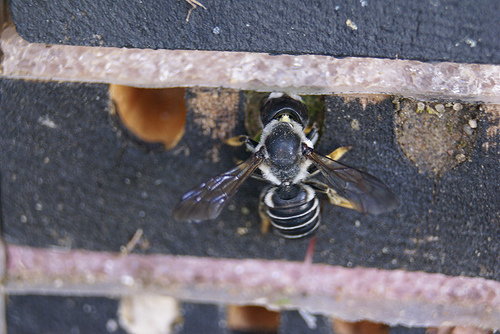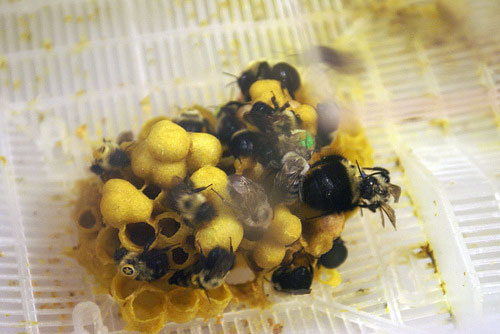
Resonating Bodies
Bumble Domicile (part 1)

Sarah Peebles - audio material, audio programming; overall concept Rob King - visual programming and projection, data gathering; concept Anne Barros - metal work Su Sheedy - encaustic/mixed media work Rob Cruickshank - ultra-violet video, technical assistance Resonating Bodies Resonating Bodies is a new media installation-in-progress and community outreach project which focuses on biodiversity of pollinators in the natural and urban ecosystems of the Greater Toronto Area (GTA). The installation, created in consultation and collaboration with bee/pollinator researchers Michael Otterstatter, Laurence Packer, Peter Hallet (Ontario) and Stephen Buchman (Arizona), will illuminate aspects of biodiversity such as bumblebee hive communication, ultraviolet bee vision, pollinator/plant co-evolution, solitary bee and wasp nesting life, and colour-coded DNA barcodes of pollinating insects involved in the project.
|
You can view our research as it progresses at Rob’s flicker site: Download: "Hive Study no. 2" audio example (4:25 dur) 5MB You can hear more of these sounds mixed with birds and other material in the previous works "Lift", "BeeSpace" (with Nilan Perera, guitar), and "Clear Dawn" (in 3 parts). Go to Sonus.ca and search "Peebles"; then select from the MP3 files with notes. |

Top: leafcutter bee (megachile pugnata) at a trap nest designed by Peter Hallett, who is recording competetive interactions of solitary bees and wasps within trap nests via sensus at Toronto area sites. Photo: Rob Cruickshank, at Koffler Scientific Reserve at Jokers Hill – University of Toronto. Above: bombus nest (Toronto-area species) at Thomson Lab, University of Toronto, courtesy Michael Otterstatter, who is studying pathogen transmission in bumblebees. Photo: Rob Cruickshank. Introduction When we think of bees, we tend to think of honey, wax candles,venomous stings, "traditional" and reinvented apitherapies. As of late, we ponder more seriously their declining numbers and mass disappearing acts, and how we utterly rely on them for much of our food. Most of which is true and which is relevant — regarding the world of honeybees. What most of us aren't aware of are the 19,000 (and counting) diverse species of bees world-wide (most of which are not honeybees; hundreds of which are found in Canada), their ancient associations with plants and ecosystems which make up the world as we know it, and their place in the bigger picture of the earth's pollination story. This story includes moths, butterflies, beetles, birds, wasps, bats and even a few larger mammals. It involves "pollination corridors" — routes which maintain migrating pollinators like humming birds and Monarch butterflies — which can extend thousands of miles, from the Arctic to Mexico. It encompasses a wide variety of survival strategies on the parts of pollinating animals and the plants on which they depend, strategies honed through the ages in an ever-evolving dance of adaptation through time and change, including change resulting from human presence. It involves genetic diversity, that essential ingredient to the survival of any living thing on Earth, including us. So, who are these indigenous bees? Most of us know so little about them: where they live, when they live and when they're active, what they look like, how they nest, what they eat, where they forage, how they navigate, how they communicate, what they pollinate. We don't even really know if or how they positively effect — or might effect — our capacity to produce food sustainably, given our penchant for monocultural practices (including the pollinators we use). It is known that there are at least some 800 species of indigenous bees in Canada, perhaps 150 of which still exist in the Greater Toronto Area. Some live in small groups, most live entirely alone, in their very own apartments. And somehow they manage to make it through the Winter. Let's meet them, up close and personal. |
»»» BACK TO TOP
![]()
Home Page |
Artist Biography |
Recordings & Publications |
Online Audio/Video
Projects & Performances |
Reviews |
Archives 2001-2011 |
The Audible Woman
Contact the artist at sarahpeebles @ gmail.com